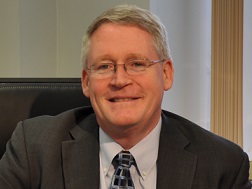Steven Lang Retires, Volpe Begins National Search for Successor
Steven Lang, director of Air Traffic Systems and Operations, will retire from Volpe on October 31. Lang joined Volpe in 2011 and has a career spanning nearly 40 years in air traffic control and air traffic management, beginning with the U.S. Air Force in 1976 and moving to the Federal Aviation Administration (FAA) in 1984.
“We’ve accomplished so much on behalf of FAA since I joined Volpe, and it’s been a privilege to play a part in advancing the safety and security of America’s airspace,” Lang said. “Volpe is a special place with some of the brightest transportation researchers in the world. I’m sorry to go, but I’m excited to begin the next phase of my life.”
After serving in the Air Force as an air traffic controller, Lang held several positions at St. Louis Tower and Approach Control, including air traffic controller, front line manager, traffic management officer, and operations manager. Before coming to Volpe, Lang managed FAA's Wake Turbulence Research Program, which delivers safe changes to air traffic operations that improve the capacity and efficiency of the nation’s airspace. He also helped define new automation tools for controllers.
“With Steve’s operational background and first-hand experience in air traffic control, he really understood what the end users, the controllers, needed,” said retired FAA Chief Scientist and Technical Advisor for Wake Turbulence, George Greene. “He brought a few fundamental shifts in wake turbulence research—focusing on how to address turbulence affecting smaller planes, focusing on where turbulence is not, rather than where it is. These are very obvious things to an operational person, and Steve’s the one who made wake turbulence research much more applicable to controllers’ day-to-day work. He understood controllers’ concerns and brought a trust factor that was critical to their acceptance of new procedures. Steve was instrumental in making the benefits of wake turbulence mitigation part of everyday operations of the National Airspace System.”
Lang also helped change national standards to allow the use of closely spaced parallel runway operations during instrument meteorological conditions—where there is a low ceiling and low visibility—at six airports. He received an award from the Secretary of Transportation and from the FAA Administrator for this work.
Based on the success of Lang’s earlier work, he initiated the FAA Wake Turbulence Recategorization (Wake RECAT) program. Wake RECAT is a revamping of the separation rules for all aircraft operating in a metropolitan area, and has been implemented in New York City, Chicago, Atlanta, and several other areas. Annual time and fuel savings from Wake RECAT reach at least into the tens of millions of dollars.
“FAA’s wake turbulence team will miss Steve tremendously, but we know this area of research is in good hands with the Volpe staff Steve has assembled,” said FAA Wake Turbulence Research Office Manager Jeffrey Tittsworth.
Under Steve’s leadership, Volpe’s Center for Air Traffic Systems and Operations grew in staffing, funding, and scope of work. Among Steve’s lasting contributions to Volpe is fostering a new generation of staff who will carry on Volpe’s role in aviation.
“Steve is leaving behind some huge shoes to fill,” said Volpe Deputy Director for Research and Technology Anne Aylward. “But, we’re confident that with Volpe’s role as a national leader in transportation research, we will attract superior leaders in the aviation field who are ready to take up Steve’s mantle.”
Volpe has begun a national search for its next director of Air Traffic Systems and Operations, who will continue Steve’s tradition of transformative wake turbulence research and take aviation safety and efficiency research in innovative directions.

